Built-in Channels Guide¶
Built-in Channels are channels that do not have a 3rd party web application that provides their functionality, but instead have functionality provided entirely by Cloudpipes. Built-in channels can be found in the middle tab on the sidebar.

Clock¶
In the Clock section there is currently only one Pipe – Pause. Pause stops (pauses) pipeline execution for the specified amount of time and then resumes. Think of it as a ‘sleep‘ function. You can use the Pause pipe whenever you need to wait for some known amount of time. For example to avoid updating objects too fast, or to avoid race conditions in your pipelines.
For a detailed description of the supported syntax refer to Clock Syntax Guide.

Note: If you need a pipeline to be executed at set-times and regular intervals see Scheduling.
Desktop Notification¶
Send a Notification pipe will pop a browser desktop notification balloon on screen. Among other things this pipe is also useful for debugging purposes.
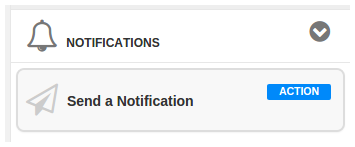
You can configure the balloon Title, Body, Icon and a URL you want to be opened once the balloon gets clicked.
Email¶
In Email you will find pipes that work with a mail server provided by Cloudpipes.

- [Trigger] New Inbound Email - Will trigger when a messaged has been received at the given address:

Note: Just like with any other pipe that has the blue ‘+’ filter button you can set filter conditions.
- [Action] Send an Email - Sends an email. You can set To, Subject, Body and after expanding the more fold - CC and BCC.
Note: Send an Email is rate limited so that it cannot be used for malicious purposes. Also the number of recipients in the To, CC and BCC are administratively capped for the same reasons.
RSS¶

- [Trigger] New Feed Item - Will trigger when an item is added to the given feed. Feed URL is configurable and after the ‘more‘ fold you can also specify authentication parameters if needed.
Note: Just like with any other pipe that has the blue ‘+’ filter button you can set filter conditions.
- [Action] Create Feed Items - is a pipe that allows you to add items to an RSS feed that is served by Cloudpipes. You can name your feed and choose a custom slug. The URL at which your feed will be available is also visible in the create dialog:
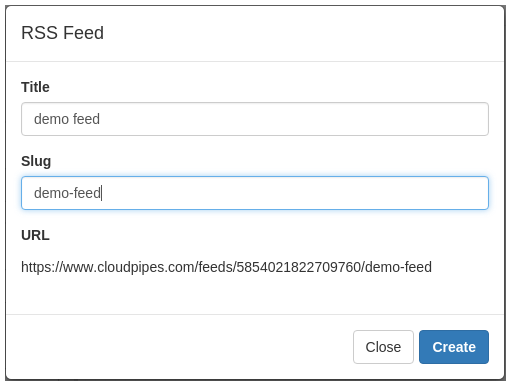
In the ‘Create Feed Items’ pipe you can specify Feed, Title, Description, Link and Publish Date. After the more fold Author, GUID and Updated at become available as fields.
- [Query] Search Feed Items - Allows you to fetch (list) the feed items available at the given URL. You can order them by a specific field and limit the number of items to fetch. The blue ‘+’ filter button, as usual, allows you to set filter conditions as usual.
SMS¶
The Send a Text Message pipe will send a text. You can specify number to send To and the Body of the text. Body is limited in length to 1600 characters.

Note: Currently only UK numbers can be texted.
Regular Expression¶
A Regular Expression is a sequence of symbols and characters expressing a string or pattern to be searched for within a longer piece of text. Regular Expressions are extremely useful for when you have a single field that contains information you need split out into multiple fields. You may only want part of that field to come through.
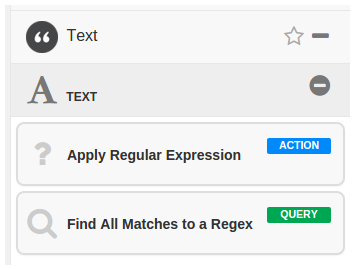
- The Apply Regular Expression pipe applies the regular expression given in Regular Expression to the text provided in the Text field. For a reference of the supported syntax please refer to regex syntax. You can also use Pythex to test your regular expression.
- The Find All Matches to a Regex query pipe will apply a regular expression (specified in Regular Expression) on a text (Text) and return all non-overlapping matches of the regex. As with all the other Search pipes Cloudpipes offers you can Order by a specified field and set a Limit on the number of results you are interested in.
Sentiment Analysis¶
Extract Sentiment is a pipe that performs natural language processing (NLP) on the supplied text and extracts a positive/negative sentiment.
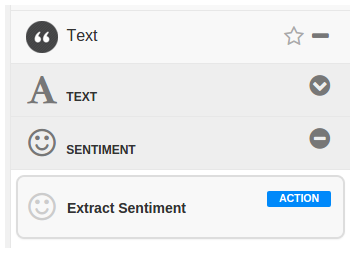
As visible in the output of the Extract Sentiment pipe :

Among other fields you get the extracted Strength and Polarity of the given Text.
Note: We use Alchemy as the NLP engine for Extract Sentiment.
Webhooks¶
A webhook is an HTTP callback - an HTTP POST that occurs when something happens. Webhooks are used as a simple event-notification mechanism via HTTP POST requests.

- [Trigger] Incoming Request will fire when an HTTP POST request is made to the provided address:
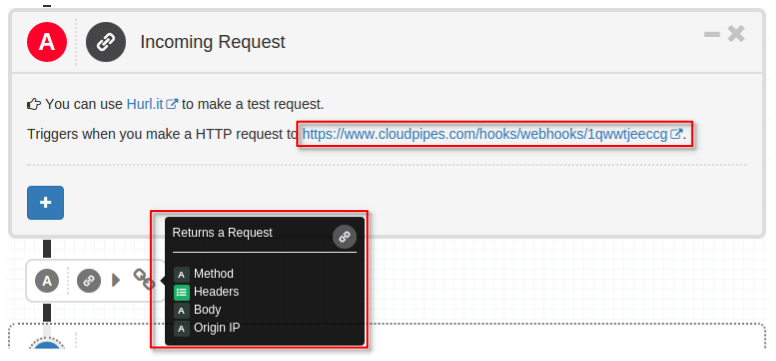
The URL to make requests to in order for the trigger to fire is shown in the pipe. From the output of Incoming Request you get HTTP Method, Headers, Body and Origin IP of the request made.
Note: You can use Hurl.it to make a test request and make sure all works as expected.
- [Action] Make a Request is the pipe to use when you want to make a webhook request :
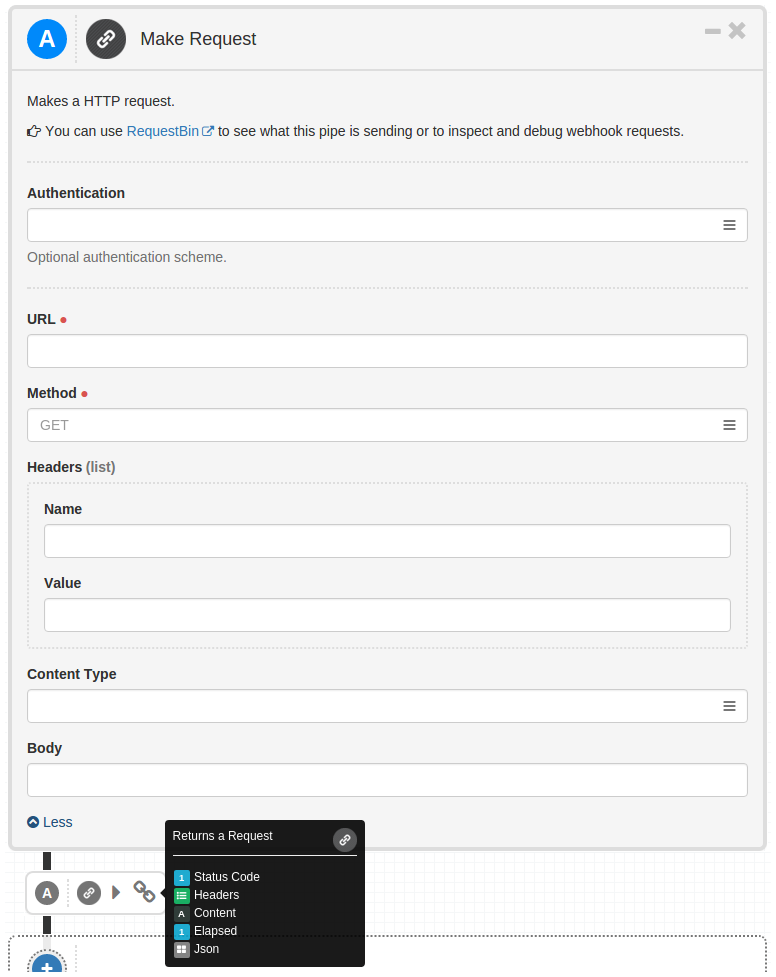
Parameters you can configure include Authentication Method, URL to make the request to, HTTP Method to use, Content-Type, the Body of the request and an optional list of Headers that is available after unfolding more.
In the Output of Make a Request you get Status Code of the response to the request made, a list of Headers, time Elapsed, response Content as text and also a json object that will have accessible fields for the cases when the remote service returns a JSON object.
Hints:
You can use RequestBin or httpbin to see what this pipe is sending or to inspect and debug webhook requests.
You can use
to_jsonfilter to obtain json representation of any object, or part of it. for example doing{{a|to_json}}, where pipe A exports a Trello card will result in:{ "id": "57adaedfdf614dca6af0c77d", "description": "This is the description.\nC.", "members": [ "5576b2fd9f60f708ad286470" ], "position": 2048, "short_id": "6", "attachments_count": 0, "short_url": "https://trello.com/c/g8GRSMOe", "closed": false, "name": "Example Name", "labels": [ { "uses": 3, "id": "55b9e9ed19ad3a5dc2f3cf58", "color": "green", "name": null }, { "uses": 3, "id": "55b9e9ed19ad3a5dc2f3cf5d", "color": "blue", "name": null } ], "updated_at": "2016-08-12T11:11:27.099000+00:00", "board": "55b9e9ed5ae0424917b5eec6", "list": "55b9e9ed5ae0424917b5eec7", "due_date": "2016-08-12T21:00:00+00:00" }
Bucket¶
The Bucket allows you to store arbitrary items and retrieve them later. You can have as many Buckets as you may need. Buckets can be named and also can hold an arbitrary number of items.

- [Trigger] Object Created - Will trigger when an item is added to the Bucket having the specified name.
- [Trigger] Object Updated - Will trigger when an item is updated in the Bucket having the specified name.
- [Action] Add of update object - Adds or updates the specified item (Resource) to the Bucket and assigns the specified ID to it for later retrieval.